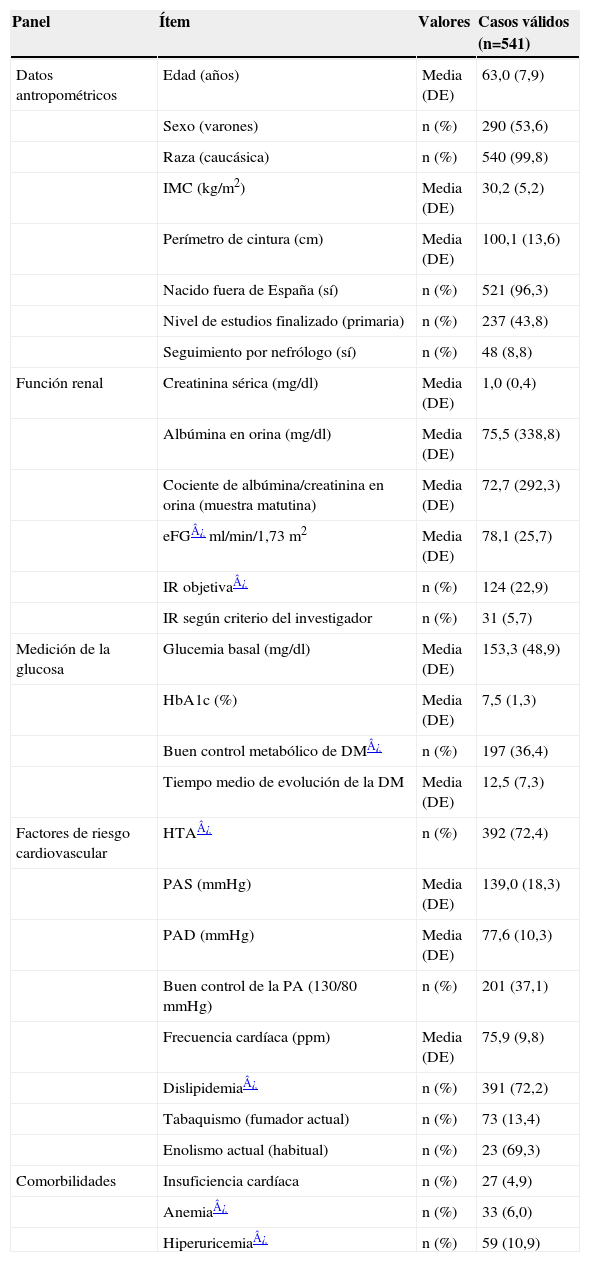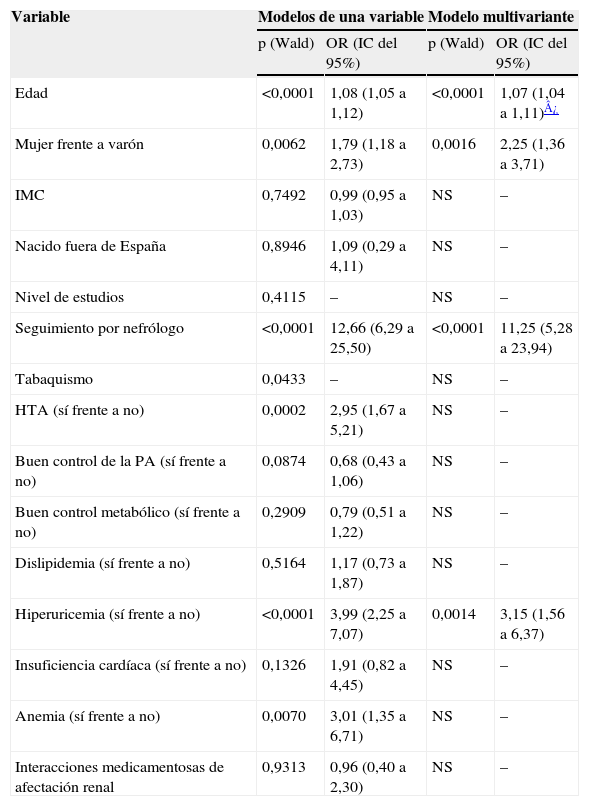El objetivo principal del estudio fue determinar la prevalencia actual de insuficiencia renal crónica (IRC) en pacientes ambulatorios con diabetes mellitus tipo 2 (DM2), en seguimiento en los servicios de Endocrinología a nivel nacional.
Pacientes y métodoEstudio con diseño observacional, transversal, multicéntrico y con recogida de datos retrospectiva. De cada participante se registraron datos demográficos y antropométricos, de función renal, de la diabetes, de factores de riesgo cardiovascular, comorbilidades y tratamientos. La presencia de IRC fue definida con un filtrado glomerular inferior a 60ml/min/1,73m2, y se utilizó el método Modification in Diet of Renal Disease abreviado.
ResultadosSe incluyeron 541 pacientes con DM2 de ambos sexos (el 53% eran varones), con una edad media (DE) de 63 años (7,9) y una hemoglobina glucosilada media del 7,6% (1,3). La prevalencia (intervalo de confianza [IC] del 95%) de IRC fue del 22,9% (IC del 95%: 19,4–26,7), superior a la estimada previamente, que fue del 5,7% (IC del 95%: 3,9–8,0) (p<0,0001). Como factores de riesgo de tener IRC se identificaron la edad (odds ratio [OR]: 2,07 [IC del 95%: 1,47–2,91] por cada 10 años de aumento), el sexo femenino (OR: 2,25 [IC del 95%: 1,36–3,71]) y la hiperuricemia (OR: 3,15 [IC del 95%: 1,56–6,37]). No hubo diferencias en el control metabólico entre los pacientes con IRC frente a sin IRC objetiva.
ConclusiónUn 22,9% de los pacientes con DM2 seguidos de manera ambulatoria por endocrinólogos presenta IRC y de esta población sólo está diagnosticada una cuarta parte. La determinación automatizada del aclaramiento de creatinina podría incrementar el porcentaje de diagnóstico y facilitar un mejor control metabólico en estos pacientes.
The aim of this study was to estimate the current prevalence of Chronic Renal Insufficiency (RI) in ambulatory patients with type 2 Diabetes (T2DM) assisted in Endocrinology Departments all over Spain.
Patients and methodsThis was an observational, cross sectional, multicenter study. From each participant the following data were retrospective collected: demographic, anthropometric, renal function, diabetes, cardiovascular risk factors, comorbidities and treatment. RI was defined by a glomerular filtration rate lower than 60ml/min/1.73m2, using the shortened MDRD method.
Results541 patients with T2DM were included, 53% were men, the mean age (DS) was 63 years old (7.9) and the HbA1c was 7.6 % (1.3). The prevalence (CI95%) of RI was 22.9% (19.4–26.7), higher than the previous estimate, witch was 5,7% (3.9–8.0, p<0,0001). The associated risk factor for RI were age (OR 2.07; 95%CI: 1.47–2.91 per each ten year period of increase), female gender (OR 2.25; 95%CI: 1.36–3.71) and hyperuricemia (OR 3.15; 95% CI: 1.56–6.37). There were no differences in the metabolic control between patients with RI vs those without RI.
Conclusions22.9% of T2DM ambulatory patients followed by endocrinologist had RI, but just a quarter of them had previously been diagnosed. The automated determination of creatinine clearance could increase the proportion of diagnosis and facilitate the improvement of the metabolic control in these patients.
Artículo
Comprando el artículo el PDF del mismo podrá ser descargado
Precio 19,34 €
Comprar ahora









